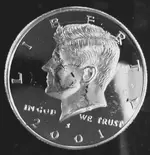blueberra
Full Member
- Joined
- Oct 15, 2009
- Messages
- 219
- Reaction score
- 708
- Golden Thread
- 0
- Location
- Massachusetts
- Detector(s) used
- Deus XP
- Primary Interest:
- Metal Detecting
... for me, at least.
Last week's half dollar box was a near-skunk, save for a single coin.
Like a lot of you, I unwrap the rolls and look at the rim. If I see 'not copper', then I investigate (also, if I see what appears to be a wire rim, I'll look to see if it's an impaired proof).
A bright white coin was the object of my interest and it led me down a bit of a path. See attached photos.
The coin in question was a 2001S impaired proof, but was it a clad proof that had been silver plated (I've come upon a couple of clad non-proofs that had been silver plated -- for what reason, I'm clueless) or an actual 90% silver proof?
Recall that a clad half dollar checks in at about 11.34 grams and a 90% silver one at about 12.5 grams.
The only way I thought to make that determination was to weigh it, but my kitchen scale wasn't accurate enough, so I went to my local pawn shop to find out.
Sure enough, my coin actually weighed about 12.6 grams (the clerk weighed a Walking Liberty and 1964 Kennedy half for comparison and they each checked in around 12.4 grams). There is slight variation allowed at the mint, but I would attribute this difference to wear.
I brought along a very worn (Fair - AG condition) Walking Liberty half that I got in the reject bin of a coin machine a couple of weeks ago. It checked in at 11.7 grams.
So unless someone decided to heavily silver plate a clad 2001S proof half, I got a cracked-out 90% one from a silver proof set.
BTW, I wonder if any unscrupulous characters silver plate impaired proof Kennedy halves to try to pass them off as 90% silver -- like the 1883 "No Cents" Liberty ("V") nickels that were gold plated and pawned off as a new design of the $5 gold piece.
Last week's half dollar box was a near-skunk, save for a single coin.
Like a lot of you, I unwrap the rolls and look at the rim. If I see 'not copper', then I investigate (also, if I see what appears to be a wire rim, I'll look to see if it's an impaired proof).
A bright white coin was the object of my interest and it led me down a bit of a path. See attached photos.
The coin in question was a 2001S impaired proof, but was it a clad proof that had been silver plated (I've come upon a couple of clad non-proofs that had been silver plated -- for what reason, I'm clueless) or an actual 90% silver proof?
Recall that a clad half dollar checks in at about 11.34 grams and a 90% silver one at about 12.5 grams.
The only way I thought to make that determination was to weigh it, but my kitchen scale wasn't accurate enough, so I went to my local pawn shop to find out.
Sure enough, my coin actually weighed about 12.6 grams (the clerk weighed a Walking Liberty and 1964 Kennedy half for comparison and they each checked in around 12.4 grams). There is slight variation allowed at the mint, but I would attribute this difference to wear.
I brought along a very worn (Fair - AG condition) Walking Liberty half that I got in the reject bin of a coin machine a couple of weeks ago. It checked in at 11.7 grams.
So unless someone decided to heavily silver plate a clad 2001S proof half, I got a cracked-out 90% one from a silver proof set.
BTW, I wonder if any unscrupulous characters silver plate impaired proof Kennedy halves to try to pass them off as 90% silver -- like the 1883 "No Cents" Liberty ("V") nickels that were gold plated and pawned off as a new design of the $5 gold piece.
Attachments
Upvote
5





